View in other NatureServe Network Field Guides
NatureServe
Montana
Utah
Wyoming
Idaho
Wisconsin
British Columbia
South Carolina
Yukon
California
New York
Meadow Fritillary - Boloria bellona
Native Species
Global Rank:
G5
State Rank:
S5
Agency Status
USFWS:
USFS:
BLM:
External Links
General Description
[From Ferris and Brown 1981; Scott 1986; Opler and Wright 1999; Glassberg 2001; Pyle 2002] Forewing 2.2-2.5 cm. The forewing outer margin angled and cutoff (truncated as if clipped). Uppersurface yellow-orange with a heavy black pattern, submarginal brown triangles on hindwing point inward; undersurface of the hindwing mottled purple-brown, with a plough-shaped costal patch at base, and lacking a strong postmedian band.
Phenology
Three flights in the southeast, mid-May to early September; two flights in central Alberta and Quebec, late May to August; one flight in Colorado, mid-June to July; one flight in Washington late May to early July (Scott 1986). One flight early May to late August in Washington (Pyle 2002); one or two flights in British Columbia, late May to late August (Guppy and Shepard 2001); two flights, May to early September at most locations (with a single flight at higher elevations), one flight June to July in the Pacific Northwest (Glassberg 2001).
Diagnostic Characteristics
Best determined by a combination of the outer forewing margin squared-off or coming to a shallow point (truncated, not smoothly rounded), upper surface of hindwing without a black border.
Species Range
Montana Range
Range Descriptions
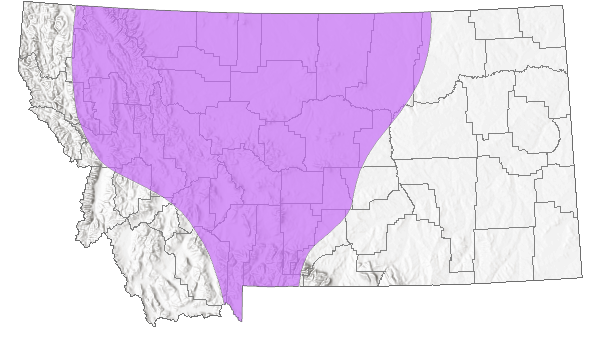
 Native
Native
Range Comments
Northen British Columbia east across boreal Canada to Labrador and Quebec, the upper Midwest and New England and south to Georgia, south in the west to northeastern Oregon and in the Rocky Mountains to southwestern Colorado (Scott 1986; Opler and Wright 1999); to at least 2745 m elevation in Colorado (Brown 1957), 1525 m elevation in Washington (Pyle 2002; Pfeiler 2013). In Montana, reported from several counties in the northwestern and north-central part of the state (Kohler 1980; Stanford and Opler 1993), south to Gallatin County. Locally rare to locally uncommon in the west, but localy common in Saskatchewan (Glassberg 2001).
Observations in Montana Natural Heritage Program Database
Number of Observations: 1
(Click on the following maps and charts to see full sized version)
Map Help and Descriptions
Relative Density
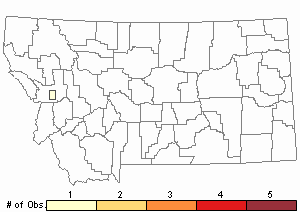
Recency
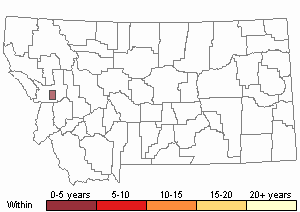
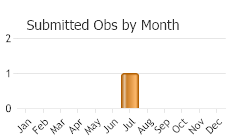
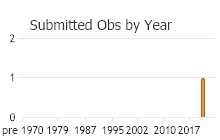
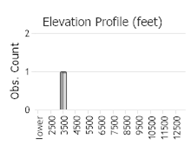 (Observations spanning multiple months or years are excluded from time charts)
(Observations spanning multiple months or years are excluded from time charts)
Migration
Non-migratory.
Habitat
Moist montane meadows, aspen parkland, willow thickets, sagebrush, pine woodland, Palouse prairie, tallgrass prairie, streamsides (Brown 1957; Scott 1986; Swengel 1997; Opler and Wright 1999; Glassberg 2001; Guppy and Shepard 2001; Pyle 2002). Habitat in Montana not described.
Food Habits
Larval food plants include several species of Viola (Scott 1986, 1992; Swengel 1997; Guppy and Shepard 2001; Pyle 2002). Adults feed on flower nectar, including Penstemon and Senecio (Scott 2014).
Reproductive Characteristics
Females lay as many as 85 eggs singly and haphazardly on twigs, grass stems and various other plants, infrequently on the larval host plant (Scott 1986, 1992; James and Nunnallee 2011). Eggs hatch in 5-7 days (depending on temperature), pupate as L5 instars in about 17-20 days after hatching, with another 7-14 days for adults to emerge (eclose) from pupae. Larvae feed at night, do not build nests, and rest under cover; overwinters (hibernates) as L4 instar (James and Nunallee 2011). Males patrol throughout the day in meadows and in openings along streams in search of females (Scott 1986; James and Nunnallee 2011).
Stewardship Responsibility
References
- Literature Cited AboveLegend:
 View Online Publication
View Online Publication Brown, F.M. 1957. Colorado Butterflies. Proceedings; Numbers Three through Seven. Denver Museum of Natural History, Denver, Co.
Brown, F.M. 1957. Colorado Butterflies. Proceedings; Numbers Three through Seven. Denver Museum of Natural History, Denver, Co. Ferris, C.D. and F.M. Brown (eds). 1981. Butterflies of the Rocky Mountains. Univ. of Oklahoma Press. Norman. 442 pp.
Ferris, C.D. and F.M. Brown (eds). 1981. Butterflies of the Rocky Mountains. Univ. of Oklahoma Press. Norman. 442 pp. Glassberg, J. 2001. Butterflies through Binoculars: A Field Guide to the Butterflies of Western North America. Oxford University Press.
Glassberg, J. 2001. Butterflies through Binoculars: A Field Guide to the Butterflies of Western North America. Oxford University Press. Guppy, C.S. and J.H. Shepard. 2001. Butterflies of British Columbia: including western Alberta, southern Yukon, the Alaska Panhandle, Washington, northern Oregon, northern Idaho, northwestern Montana. UBC Press (Vancouver, BC) and Royal British Columbia Museum (Victoria, BC). 414 pp.
Guppy, C.S. and J.H. Shepard. 2001. Butterflies of British Columbia: including western Alberta, southern Yukon, the Alaska Panhandle, Washington, northern Oregon, northern Idaho, northwestern Montana. UBC Press (Vancouver, BC) and Royal British Columbia Museum (Victoria, BC). 414 pp. James, D.G. and D. Nunnallee. 2011. Life histories of Cascadia butterflies. Corvallis, OR: Oregon State University Press. 447 p.
James, D.G. and D. Nunnallee. 2011. Life histories of Cascadia butterflies. Corvallis, OR: Oregon State University Press. 447 p. Kohler, S. 1980. Checklist of Montana Butterflies (Rhopalocera). Journal of the Lepidopterists' Society 34(1): 1-19.
Kohler, S. 1980. Checklist of Montana Butterflies (Rhopalocera). Journal of the Lepidopterists' Society 34(1): 1-19. Opler, P.A. and A.B. Wright. 1999. A field guide to western butterflies. Second edition. Peterson Field Guides. Houghton Mifflin Company, Boston, Massachusetts. 540 pp.
Opler, P.A. and A.B. Wright. 1999. A field guide to western butterflies. Second edition. Peterson Field Guides. Houghton Mifflin Company, Boston, Massachusetts. 540 pp. Pfeiler, E. 2013. Boloria bellona (Fabricius)(Nymphalidae: Heliconiinae) from the Blue Mountains of the Pacific Northwest. Journal of the Lepidopterists' Society 67(2): 143-144.
Pfeiler, E. 2013. Boloria bellona (Fabricius)(Nymphalidae: Heliconiinae) from the Blue Mountains of the Pacific Northwest. Journal of the Lepidopterists' Society 67(2): 143-144. Pyle, R.M. 2002. The butterflies of Cascadia: a field guide to all the species of Washington, Oregon, and surrounding territories. Seattle Audubon Society, Seattle, Washington. 420 pp.
Pyle, R.M. 2002. The butterflies of Cascadia: a field guide to all the species of Washington, Oregon, and surrounding territories. Seattle Audubon Society, Seattle, Washington. 420 pp. Scott, J.A. 1986. The butterflies of North America: a natural history and field guide. Stanford University Press, Stanford, California.
Scott, J.A. 1986. The butterflies of North America: a natural history and field guide. Stanford University Press, Stanford, California. Scott, J.A. 1992. Hostplant records for butterflies and skippers (mostly from Colorado) 1959-1992, with new life histories and notes on oviposition, immatures, and ecology. Papilio new series #6. 185 p.
Scott, J.A. 1992. Hostplant records for butterflies and skippers (mostly from Colorado) 1959-1992, with new life histories and notes on oviposition, immatures, and ecology. Papilio new series #6. 185 p. Scott, J.A. 2014. Lepidoptera of North America 13. Flower visitation by Colorado butterflies (40,615 records) with a review of the literature on pollination of Colorado plants and butterfly attraction (Lepidoptera: Hersperioidea and Papilionoidea). Contributions of the C.P. Gillette Museum of Arthopod Diversity. Fort Collins, CO: Colorado State University. 190 p.
Scott, J.A. 2014. Lepidoptera of North America 13. Flower visitation by Colorado butterflies (40,615 records) with a review of the literature on pollination of Colorado plants and butterfly attraction (Lepidoptera: Hersperioidea and Papilionoidea). Contributions of the C.P. Gillette Museum of Arthopod Diversity. Fort Collins, CO: Colorado State University. 190 p. Stanford, R.E. and P.A. Opler. 1993. Atlas of western USA butterflies: including adjacent parts of Canada and Mexico. Unpubl. Report. Denver and Fort Collins, Colorado 275 pp.
Stanford, R.E. and P.A. Opler. 1993. Atlas of western USA butterflies: including adjacent parts of Canada and Mexico. Unpubl. Report. Denver and Fort Collins, Colorado 275 pp. Swengel, A.B. 1997. Habitat associations of sympatric violet-eating fritillaries (Euptoeita, Speyeria, Boloria)(Lepidoptera: Nymphalidae) in tallgrass prairie. Great lakes Entomologist 30(1/2): 1-18.
Swengel, A.B. 1997. Habitat associations of sympatric violet-eating fritillaries (Euptoeita, Speyeria, Boloria)(Lepidoptera: Nymphalidae) in tallgrass prairie. Great lakes Entomologist 30(1/2): 1-18.
- Additional ReferencesLegend:
 View Online Publication
View Online Publication
Do you know of a citation we're missing? Allen, T.J., J.P. Brock, and J. Glassberg. 2005. Caterpillars in the field and garden: a field guide to the butterfly caterpillars of North America. Oxford University Press.
Allen, T.J., J.P. Brock, and J. Glassberg. 2005. Caterpillars in the field and garden: a field guide to the butterfly caterpillars of North America. Oxford University Press. Brock, J.P. and K. Kaufman. 2003. Kaufman Field Guide to Butterflies of North America. Houghton Mifflin Company, New York, NY 284 pp.
Brock, J.P. and K. Kaufman. 2003. Kaufman Field Guide to Butterflies of North America. Houghton Mifflin Company, New York, NY 284 pp. Forister, M.L., E.M. Grames, C.A. Halsch, K.J. Burls, C.F. Carroll, K.L. Bell, J.P. Jahner, et al. 2023. Assessing risk for butterflies in the context of climate change, demographic uncertainty, and heterogeneous data sources. Ecological Monographs 93(3):e1584. https://doi.org/10.1002/ecm.1584
Forister, M.L., E.M. Grames, C.A. Halsch, K.J. Burls, C.F. Carroll, K.L. Bell, J.P. Jahner, et al. 2023. Assessing risk for butterflies in the context of climate change, demographic uncertainty, and heterogeneous data sources. Ecological Monographs 93(3):e1584. https://doi.org/10.1002/ecm.1584 Layberry, R.A., P.W. Hall, and J.D. LaFontaine. 1998. The Butterflies of Canada. University of Toronto Press. 280 pp. + color plates.
Layberry, R.A., P.W. Hall, and J.D. LaFontaine. 1998. The Butterflies of Canada. University of Toronto Press. 280 pp. + color plates.
- Web Search Engines for Articles on "Meadow Fritillary"
- Additional Sources of Information Related to "Insects"





